|
.
.
.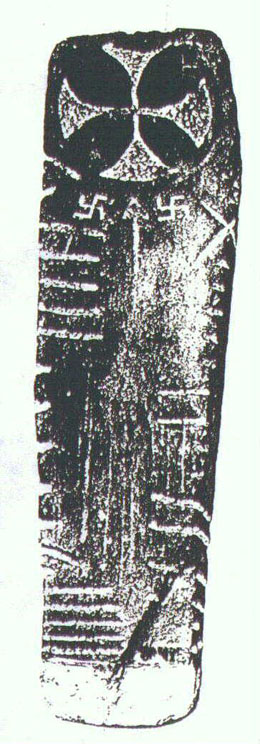 |
.This mummy like grave stone is called the Ogham stone.
It was found in Aglish, County Kerry, Ireland with both the "cross
paty" and the "swastika." It dates back to the
fifth century. Ogham was the only known form of writing to the
pre-Christian Irish. The swastika was common to nearly all ancient
civilizations. It was a symbol of spiritual resignation for the
Buddhists, and was used by the American Indians as well. The
Cross Paty Formy was the basis for the Maltese Cross, which was
popular with Hitler and the Pope tends to wear embroidered Maltese
Crosses on his priesthood garments.
The shape of the stone also resembles the casket used in
Masonic rituals.The reason I'm adding this unique piece is the
cross paty which resembles the cross used on Roman Catholic apparel
used in the priesthood. It is also found (listed in the RC Encyclopedia)
on asps and on the altar stone (a permanent or immovable table
of the altar which is made of one piece or slab of solid stone
and is consecrated as one with the rest of the altar. Specificaly,
then, it is the mensa altaris upon which is celebrated
the Mass. Since ancient times, in order for the altar to be consecrated,
it must always be made of stone.
There are five crosses carved onto the stone, one at each
corner and one in the center. The chalice and paten rest on it,
because the altar stone is the altar itself. |

|
taken from The Temple and the Lodge, by Michael
Baigent and Richard Leigh , 1989 |
|
|
This undated gravestone was found in Kilmory Celtic
Scotland. Above the warrior's head is a masonic set square. Below
is a Templar-cross forming part of the carved pattern. Notice
the cross in the top of the picture below. |
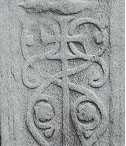 |
|
Notice the similarity between the Klu Klux Clan as
we know it today. This is also where nun's clothings came from.
See below:
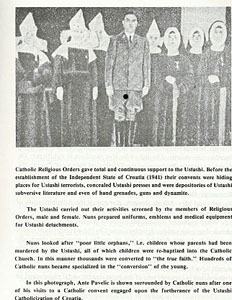
|
|
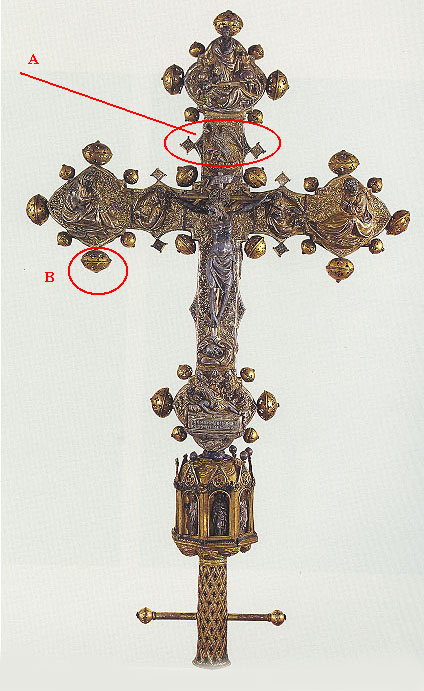
|
Nicola da Guardiagrele, Processional Cross , 1434
(cat. no. 132) Vatican Treasures 2000 Years of Art and
Culture in the Vatican and Italy, p 201 |
|
(A) In the circle over the head of Jesus is a Phoenix,
an Eagle feeding its young which is a symbol of immortality of
the human soul to Manly P. Hall, 33rd Degree Mason. In his book
"The Secret Teaching of All Ages, the Eagle was one of the
original three symbols of Scorpio, and served as an emblem of
the theurgic art and secret processes (magic, the same as did
the Goat of Mendes). The Phoenix is reborn out of its own dead
body seven times seven, the "spiritual nature" of man
also is reborn again and again in triumph (reincarnation) over
his dead physical body. To the Egyptians, the Phoenix was a symbol
of regeneration.
(B) The circled container is used for incense. In this
case the cross is covered with them. On portraits of Masons,
one will usually find one of those by their hand which was the
one criteria one could count on if the person was a Mason.
 |
This Freemason apron is one of many different designs
which are embroidered. This particular one portrays the "Phoenix",
in this case a Pelican feeding its own out of it's breast a symbol
immortality (reincarnation).It further discloses that the Pelican
of the Rose Croix Degree, feeding the "seven young"
is a Phoenix dating back to the Goat of Mendes according to Manly
P. Hall, 33rd Degree Mason. (Die Diskrete Gesellschaft, by Dieter
A. Binder 1988 p.156& 666 The Final Warning by Gary D. Blevins
p. 234) |
|
Portrait of
Gebhard Leberecht von Bluecher (1742-1819) He became a Freemason
in 1783 and was a representative of the Preussen Militia inside
the Lodge. (Die Diskrete Gesellschaft, history and symbolism
of Freemasonry by Dieter Binder 1988)
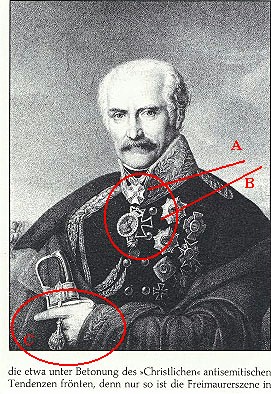
(C) Is a round ball-like container.
I have no idea what the name of it is or what it is used for.
All I know is that it serves as a signature that in this case
this man is a Mason. You will find it on portraits of politicians
who are members. It probably contains incense. |
(A) Pontifical decorations for exemplary service to the
church or society. Papal decorations include
titles of nobility (baron, knight, prince), crosses (Pro Ecclesia
et Pontifice) and medals (Benemerenti, Medal of the Holy Land).
(Catholic Encyclopedia page 289)
(B) Maltese Cross represents the Knights of Malta (Hospitallers)"
The sovereign Military Hospitaller Order of St.John of Jerusalem,
of Rhodes and of Malta is the most ancient religious order of
chivalry. The order began in Jerusalem during the First Crusade
in 1070, as a hospice-infirmary for pilgrims from Amalfi. In
1113 the institution was approved by Pope Paschal II. The Knights
are a religious order made up of lay brothers and chaplains..
Forced to leave by the Muslim invasions, they went to the island
Malta. They became temporal rulers of Malta until 1798 when Napoleon
invaded them. (Malta was under English rule). (Catholic Encyclopedia
p. 557)See next col. for more on these Knights. |
|
|